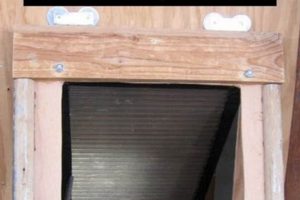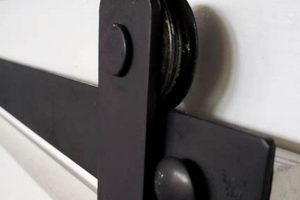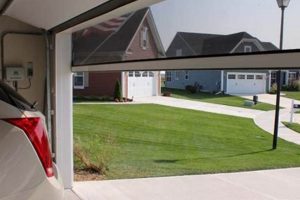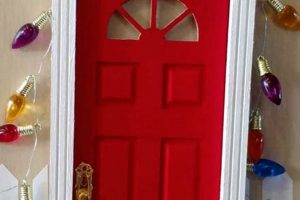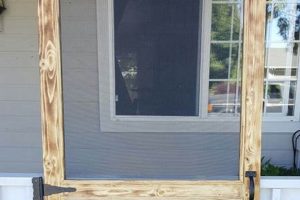The construction of self-assembled storage units featuring hinged or sliding access panels represents a significant area of interest for homeowners and hobbyists. These customized pieces of furniture provide a solution for organizing belongings within a residential space. An example would be building a unit with a frame, shelving, and a hinged front panel to store tools in a garage or create pantry storage in a kitchen.
Such projects offer cost savings compared to purchasing pre-assembled furniture and allow for complete customization to fit specific spatial constraints and aesthetic preferences. Historically, this type of creation has been driven by a desire for practical, affordable solutions and an increasing accessibility to tools and construction knowledge, leading to a widespread adoption as a home improvement endeavor. Benefits extend beyond cost and customization to include the satisfaction of creating a functional and personalized item.
The subsequent sections will delve into essential considerations for undertaking such projects, including material selection, design principles, construction techniques, and finishing processes. This will cover the necessary knowledge for successfully creating personalized and practical storage solutions.
Construction Recommendations for Enclosed Storage Units
The following recommendations provide essential guidance for achieving successful and durable self-assembled storage units. Adherence to these guidelines can mitigate common errors and enhance the longevity of the finished product.
Tip 1: Prioritize Accurate Measurements. Precise dimensional calculations are critical before commencing any cutting or assembly. Deviations from the intended dimensions can lead to structural instability or misalignment of access panels. For example, measure the intended location and interior contents before creating a design to ensure a suitable fit.
Tip 2: Select Appropriate Materials. Material choice directly impacts the unit’s strength, weight, and resistance to environmental factors. Solid wood provides durability, while plywood and MDF offer more cost-effective and dimensionally stable alternatives. Consider the intended use and environment to determine the most suitable material. For example, MDF is suitable for painted cabinets within a dry indoor area, whereas solid wood or marine-grade plywood is preferable for high-moisture environments.
Tip 3: Employ Proper Joinery Techniques. Secure and durable joints are essential for a stable structure. Techniques such as mortise and tenon, dadoes, rabbets, and pocket screws each offer varying levels of strength and complexity. Select the joinery method appropriate for the skill level and the structural requirements of the design. Glue is also critical for creating strong joints.
Tip 4: Ensure Square and Level Assembly. Maintaining square and level during the assembly process is crucial for proper door alignment and overall structural integrity. Utilize a framing square to verify right angles and a level to ensure a flat and stable base. Any deviation from square or level will compound as the assembly progresses.
Tip 5: Invest in Quality Hardware. Hinges, knobs, and pulls directly impact the functionality and aesthetic appeal of the unit. Choosing high-quality hardware ensures smooth operation and long-term durability. Poor quality hardware can lead to sagging doors, difficult opening and closing, and premature failure. Consider soft close hinge to increase lifespan and decrease noise when closing.
Tip 6: Apply a Durable Finish. A properly applied finish protects the material from moisture, scratches, and wear. Select a finish appropriate for the chosen material and intended use. Options include paint, varnish, lacquer, and stain. Always prepare the surface adequately before applying the finish. Sanding and cleaning can greatly improve finish application.
Tip 7: Install Doors with Precision. Proper door installation is vital for aesthetics and functionality. Achieving consistent gaps and even alignment requires careful measurements and adjustments. Utilize shims and spacers to fine-tune the door position. Check and double-check after completing each step.
These recommendations serve as a foundation for successful construction. By adhering to these principles, individuals can create functional and aesthetically pleasing storage solutions tailored to their specific needs and preferences.
The subsequent section will address the finishing and aesthetic customization of completed storage units.
1. Material Selection
The selection of materials fundamentally determines the structural integrity, longevity, and aesthetic qualities of any self-assembled storage unit. This choice directly impacts the ease of construction, the required tools, and the ultimate cost of the project. For example, opting for solid hardwood, such as oak or maple, provides exceptional durability and aesthetic appeal. However, it necessitates specialized tools for cutting and shaping and increases the overall expense. Conversely, utilizing medium-density fiberboard (MDF) offers a more cost-effective and readily workable option, but sacrifices some durability and moisture resistance. The practical implication is that a careful evaluation of the intended use, environmental conditions, and budget constraints must precede any material purchase.
Further, material selection influences the finishing process. Solid wood accepts stains and paints readily, allowing for a wide range of aesthetic customization. MDF, while paintable, requires a primer to seal the surface and prevent excessive paint absorption. Plywood, another common material, presents challenges in edge finishing, requiring banding or trimming to achieve a professional appearance. Consider a scenario where a storage unit is intended for a garage environment. Plywood with a durable coating might be more appropriate than MDF due to its superior resistance to moisture and temperature fluctuations, despite MDF’s smoother surface for painting. Improper material selection can lead to premature failure of the unit, rendering the project a short-term solution.
In conclusion, material selection constitutes a critical decision point within the overall process of self-assembled storage construction. This decision significantly affects structural integrity, aesthetic potential, ease of construction, and long-term durability. The key insight is that there is no universally superior material. Rather, the optimal choice depends on a nuanced assessment of specific project requirements and constraints. Challenges associated with material selection underscore the importance of careful planning and informed decision-making to ensure a successful outcome.
2. Accurate Measurement
Accurate measurement is a foundational element in the successful construction of self-assembled storage units featuring access panels. Deviations from specified dimensions can compromise structural integrity, functionality, and aesthetic appeal. Therefore, precise and deliberate dimensional control is essential throughout the design and construction phases.
- Overall Cabinet Dimensions
The initial measurements defining the width, height, and depth of the storage unit directly impact its compatibility with the intended space. Inaccurate overall dimensions can result in a unit that is too large to fit or too small to effectively utilize the available area. This necessitates pre-construction verification of spatial constraints and careful adherence to design specifications.
- Component Cutting Accuracy
Precise measurements are crucial during the cutting of individual components, such as panels, shelves, and framing members. Errors in cutting dimensions can lead to misalignment during assembly, resulting in gaps, instability, and a compromised aesthetic appearance. The use of precise measuring tools and careful cutting techniques is paramount in mitigating such errors.
- Door and Opening Tolerances
The accurate measurement of door openings and the corresponding door dimensions is critical for proper functionality. Insufficient clearance can cause binding or rubbing, while excessive clearance can result in unsightly gaps and a lack of dust protection. Precise measurement and adjustment are required to achieve smooth and reliable door operation.
- Hardware Placement Precision
The accurate measurement and marking of locations for hardware installation, such as hinges, latches, and drawer slides, are essential for proper alignment and smooth operation. Deviations from specified hardware placement can lead to misalignment, binding, or failure of the hardware components. The use of templates and precise measuring tools is recommended for accurate hardware installation.
The cumulative effect of accurate measurement across these facets directly contributes to the successful construction of self-assembled storage units with access panels. Neglecting dimensional precision can result in a compromised final product that fails to meet functional or aesthetic expectations. The integration of meticulous measurement practices is, therefore, an indispensable aspect of this construction endeavor.
3. Joinery Strength
Joinery strength is a pivotal consideration in the construction of self-assembled storage units featuring access panels. The integrity of the joints directly influences the overall durability, stability, and longevity of the structure. Inadequate joint strength can lead to premature failure, rendering the unit unsafe or unusable.
- Impact on Load-Bearing Capacity
The ability of a joint to withstand weight and stress is directly related to its design and execution. Stronger joinery techniques, such as mortise and tenon or dovetail joints, distribute load more effectively than weaker techniques like butt joints secured with screws. For instance, a storage unit intended to hold heavy items requires robust joinery to prevent sagging or collapse. The choice of joinery directly determines the unit’s functional weight limit.
- Resistance to Shear Forces
Storage units are frequently subjected to shear forces, such as those exerted when opening or closing a door. Strong joints resist these forces, maintaining the structural integrity of the frame and preventing racking. An example would be a face frame cabinet relying on strong joinery to avoid becoming loose and unstable over time. The ability to resist shear is critical for long-term functionality.
- Influence on Door Alignment and Stability
The method used to join the frame components of a storage unit directly affects the alignment and stability of the access panels. Weak joints can lead to sagging or misalignment of doors, resulting in difficult opening and closing or an unsightly appearance. Well-executed joinery ensures that the frame remains square and rigid, providing a stable mounting platform for the access panels. Even a slight loss of square can cause issues with door alignment and closing.
- Durability and Longevity Implications
The long-term durability of a self-assembled storage unit is heavily dependent on the strength and resilience of its joints. Properly executed joinery can withstand years of use and environmental changes, while weak joints are prone to loosening, cracking, or complete failure over time. Investing in strong joinery techniques and quality materials increases the lifespan of the unit, providing a greater return on investment. For example, using screws and glue vs just screws can significantly impact a cabinet’s overall lifespan.
The strength of the joinery employed in the construction of storage units with doors represents a fundamental determinant of their overall success. From load-bearing capacity to door alignment and long-term durability, strong joints are essential for creating a functional, aesthetically pleasing, and enduring storage solution. Careful consideration of joinery techniques and the proper execution thereof are therefore paramount.
4. Door Alignment
Door alignment represents a critical element in the successful execution of self-assembled storage units featuring access panels. Improper door alignment compromises functionality, aesthetic appeal, and potentially, the structural integrity of the unit. Correcting misalignment issues post-construction can be time-consuming and may require significant disassembly.
- Impact on Functionality
Misaligned doors can hinder the smooth opening and closing of the cabinet. Binding, sticking, or rubbing against the frame necessitates additional force for operation, potentially damaging hinges or other hardware over time. In extreme cases, a severely misaligned door may become completely inoperable, rendering the storage space inaccessible. A cabinet door rubbing against the bottom, creating friction and wear on both surfaces, is a typical example.
- Influence on Aesthetic Appeal
Even minor misalignments are visually noticeable and detract from the overall aesthetic quality of the finished unit. Uneven gaps between the door and frame, or between adjacent doors, create an unprofessional appearance. The perception of quality is significantly diminished by noticeable door alignment issues. For example, a DIY cabinet with one door slightly higher than the other will create an uneven look and diminish the visual appeal.
- Effect on Seal and Dust Protection
Properly aligned doors provide a tight seal against the cabinet frame, preventing the ingress of dust, moisture, and pests. Misaligned doors create gaps that compromise this seal, allowing contaminants to enter the storage space. This is particularly important for cabinets intended to store sensitive items such as food, electronics, or documents. A cabinet door with gaps may allow dust to collect on stored items, requiring more frequent cleaning.
- Relationship to Hardware Longevity
Misaligned doors place undue stress on hinges, latches, and other door hardware. This increased stress can lead to premature wear and failure of the hardware components, requiring costly repairs or replacements. Properly aligned doors allow hardware to operate smoothly and efficiently, extending their lifespan. For instance, constantly slamming a door shut due to misalignment can weaken the hinges and lead to sagging.
The connection between proper door alignment and the overall success of self-assembled storage units with access panels is undeniable. Achieving accurate door alignment requires careful measurement, precise construction techniques, and meticulous adjustment. These efforts directly translate into a functional, aesthetically pleasing, and durable storage solution.
5. Hardware Quality
Hardware quality significantly influences the performance, longevity, and overall user experience of self-assembled storage solutions with access panels. Investing in durable and reliable hardware components ensures smooth operation, prevents premature failure, and contributes to the aesthetic appeal of the finished product.
- Hinge Durability and Functionality
Hinges are fundamental to the operability of access panels. High-quality hinges, constructed from robust materials and featuring precise mechanisms, allow for smooth and consistent opening and closing. Poor-quality hinges are prone to corrosion, binding, and eventual failure, leading to sagging doors and compromised functionality. Soft-close hinges, constructed with durable mechanisms, exemplify quality by offering controlled closure, reducing noise and minimizing wear on the cabinet structure.
- Latch and Closure Mechanism Reliability
Latches and closure mechanisms secure doors in the closed position, preventing unwanted opening and ensuring the contents remain protected. Inferior latches may fail to engage properly, resulting in doors that swing open unintentionally. Magnetic catches crafted with strong magnets or roller catches made with durable springs offer reliable closure, maintaining a secure and aesthetically pleasing cabinet facade. A robust latching mechanism is critical in applications where maintaining a closed position is essential.
- Knob and Pull Material and Ergonomics
Knobs and pulls provide a tactile interface for opening and closing cabinet doors. The material composition and ergonomic design directly impact user comfort and the overall aesthetic. Inexpensive knobs made from brittle plastic are prone to breakage, while poorly designed pulls can be uncomfortable to grip. Opting for knobs constructed from solid metal or pulls with ergonomic designs enhances both the functionality and the visual appeal of the storage unit.
- Fastener Strength and Corrosion Resistance
Screws, bolts, and other fasteners secure the various components of the cabinet structure and attach hardware elements. The strength and corrosion resistance of these fasteners are crucial for maintaining structural integrity and preventing hardware detachment. Low-quality fasteners may strip easily, break under stress, or corrode over time, compromising the stability and longevity of the cabinet. Utilizing high-quality fasteners made from durable materials like stainless steel is essential, particularly in environments with high humidity.
The selection of high-quality hardware components is a fundamental aspect of creating functional and durable self-assembled storage units with doors. Compromising on hardware quality can lead to a diminished user experience, premature failure of components, and a reduced lifespan for the overall storage solution. Prioritizing hardware quality ensures long-term functionality, aesthetic appeal, and user satisfaction.
6. Protective Finish
A protective finish is an essential component in the construction of self-assembled storage solutions featuring access panels. It serves as a barrier against environmental factors and physical wear, directly influencing the longevity, aesthetic appeal, and functional performance of the finished unit. The selection and application of an appropriate finish are, therefore, critical considerations.
- Moisture Resistance
Protective finishes mitigate the harmful effects of moisture exposure, preventing warping, swelling, and decay of the underlying material. This is particularly critical in environments with high humidity or potential water exposure, such as kitchens or bathrooms. Examples include varnishes, lacquers, and specialized paints designed to repel water. Without adequate protection, moisture penetration can compromise the structural integrity of the wood or MDF, leading to premature failure. A kitchen cabinet subjected to splashes and spills is a prime example of where a moisture-resistant finish is crucial.
- Scratch and Abrasion Resistance
A durable finish protects the surface of the unit from scratches, abrasions, and other forms of physical damage. This is particularly important for high-traffic areas or surfaces that are frequently handled. Polyurethane coatings, known for their hardness and resistance to wear, provide excellent protection against scratches and abrasions. Conversely, softer finishes may be easily marred by everyday use, resulting in a worn and unsightly appearance. A frequently used shelf in a pantry cabinet, for example, benefits significantly from a scratch-resistant finish.
- UV Protection
Exposure to ultraviolet (UV) radiation from sunlight can cause fading, discoloration, and degradation of certain materials. Protective finishes containing UV inhibitors help to mitigate these effects, preserving the original color and appearance of the unit. This is particularly important for cabinets located near windows or in areas with high sun exposure. Exterior-grade finishes often incorporate UV protection to prevent fading and chalking. A bookcase placed near a window, exposed to direct sunlight, would benefit from a finish containing UV inhibitors to prevent the wood stain from fading.
- Enhancement of Aesthetic Qualities
Protective finishes not only provide functional benefits but also enhance the aesthetic appeal of the storage unit. Stains, paints, and clear coats can be used to achieve a desired color, sheen, and texture. Proper application of the finish can highlight the natural grain of the wood or create a smooth, uniform surface. A carefully applied stain and clear coat can transform a plain pine cabinet into a visually appealing and durable piece of furniture. The finish, therefore, contributes significantly to the overall aesthetic integration of the cabinet within its environment.
The selection and application of an appropriate protective finish are integral to the long-term success and aesthetic appeal of self-assembled storage solutions. From moisture resistance to UV protection and aesthetic enhancement, the finish serves as a vital barrier against environmental factors and physical wear. Therefore, careful consideration of the intended use, environmental conditions, and desired aesthetic outcome is essential in choosing the most suitable finish for the project. Selecting quality materials and following the manufacturer’s instructions during application results in durable, attractive, and long-lasting storage furniture.
Frequently Asked Questions
The following section addresses common inquiries regarding the design, construction, and maintenance of self-assembled storage units with access panels. The information provided is intended to clarify essential considerations for successful project completion.
Question 1: What are the primary considerations when selecting materials for constructing a self-assembled storage unit?
Material selection should prioritize structural integrity, resistance to environmental factors (moisture, temperature fluctuations), and aesthetic compatibility with the intended space. Cost-effectiveness and workability are secondary considerations. Options range from solid hardwoods to engineered wood products, each with distinct advantages and disadvantages.
Question 2: How can accurate measurements be ensured during the construction process?
Employ precision measuring tools (steel rules, digital calipers), verify dimensions at multiple points, and account for material thickness. Double-check all measurements before cutting or assembling components. Small dimensional errors can accumulate and significantly compromise the final product.
Question 3: What joinery techniques are most suitable for creating durable and stable storage unit construction?
Joinery selection should be based on the anticipated load and the skill level of the builder. Stronger joints, such as mortise and tenon or dovetails, are preferred for load-bearing elements. Screws and glue, while less aesthetically refined, provide adequate strength for many applications. Proper alignment and clamping during assembly are crucial regardless of the chosen technique.
Question 4: What steps are critical to achieving proper door alignment and functionality?
Ensure the cabinet frame is square and level before installing doors. Utilize shims to fine-tune door positioning and maintain consistent gaps. High-quality hinges are essential for smooth operation and long-term stability. Careful adjustment after installation may be necessary to compensate for minor imperfections.
Question 5: What are the key factors in selecting appropriate hardware for a storage unit?
Hardware selection should prioritize durability, functionality, and aesthetic compatibility. Choose hinges, latches, and pulls constructed from robust materials with reliable mechanisms. Consider the ease of operation and ergonomic design. Low-quality hardware can compromise the unit’s functionality and longevity.
Question 6: What type of protective finish is recommended for maximizing the lifespan of a self-assembled storage unit?
The choice of finish should be dictated by the intended use and environmental conditions. Moisture-resistant finishes are essential for units exposed to humidity or water. Scratch-resistant coatings are beneficial for high-traffic areas. UV-resistant finishes are recommended for units exposed to sunlight. Proper surface preparation is critical for optimal adhesion and performance.
In summary, careful planning, precise execution, and the selection of appropriate materials and components are paramount to the successful construction of enclosed self-assembled storage solutions. Attention to these details will ensure a functional, durable, and aesthetically pleasing finished product.
The subsequent section will explore advanced design considerations for customized storage solutions.
DIY Cabinet with Doors
This exploration has underscored the multifaceted nature of self-assembled storage creation. From material selection and precise measurement to joinery strength, door alignment, hardware quality, and protective finishes, each element demands careful consideration and execution. The success of such a project hinges on a comprehensive understanding of these interconnected factors and a commitment to rigorous construction practices.
The construction of a DIY cabinet with doors represents more than a mere assembly of materials; it signifies an investment in functional organization and personalized space optimization. It requires dedication to precision and informed decision-making, ultimately resulting in a storage solution tailored to specific needs and preferences. Continued refinement of skills and exploration of advanced techniques will further elevate the quality and longevity of these self-made creations.



